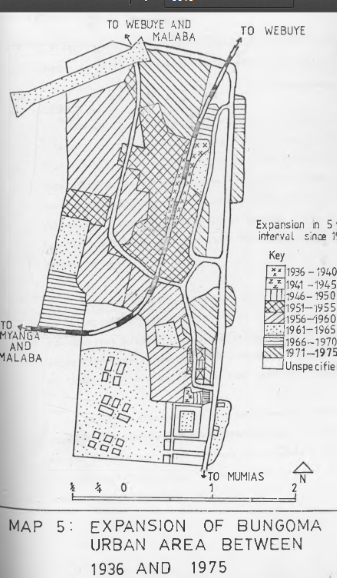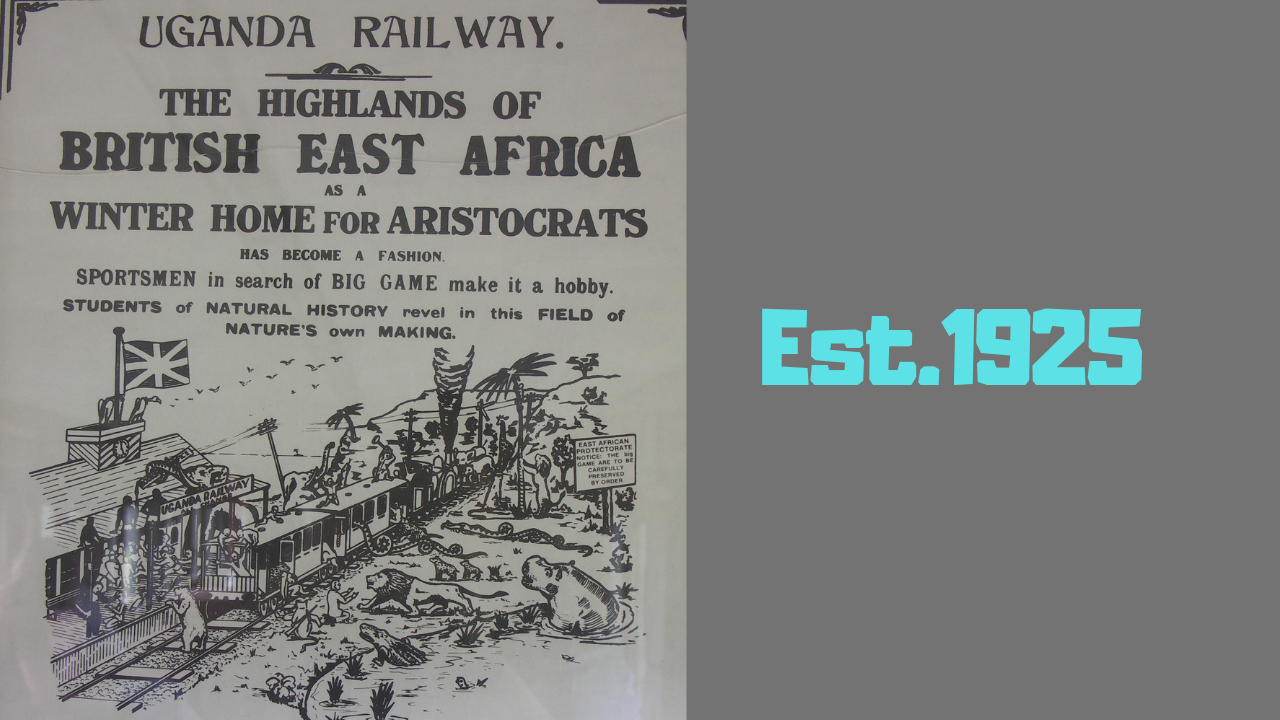By the 1962 census, Bungoma had a population of 1589. In the early eighties, this had swelled to circa 26,000. By then, starting in the late 60’s and early 70’s, the town’s residential spaces became increasingly stretched. This followed the Trade Licensing Act Number 63 of 1967 which led to Africanisation of trade. With expansion of economy activity, immigration happened; thus occasioning people immigrating into Bungoma. Most of this inhabitants ended up residing in the emerging quadruplet estates of Mandizini, Mjini, Mupeli and Mufutu. Then, as it is today, this mass of unplanned private developments were emblematic of urban decay.
In 1948, the colonial administrators of the Elgon Nyanza district of Kavirondo had a decision to make. They needed to respond to calls by local elite for an administrative capital. The divisional headquarters at Kavujai did ok; but they wanted something better. Something that could serve them better than Kakamega, that lay so many miles away.
Their first option was a small outpost. It consisted of a camping site for railway workers, a veterinary center and a few dukawallas.
They also had a choice of more vibrant, more urban site on the slopes of Mt. Masaba. After weighing the options, they elected for the small outpost. By that decision, Bungoma town was born.
Growth Of Bungoma Town
That 1962 census figure might sound comical by today’s standards; however believe us when we say that Bungoma was just a few years away from a dramatic population explosion. From 1962 onward, the few thousands of immigrants that flowed in led to the birth of twin neighborhoods of Mandizini and Mufutu alongside Mjini and Mupeli. The story of Bungoma post 1948 has been pretty much the same. The juicy part is at the beginning. When it all started.

Bungoma: What’s In A Name?
There are two urban legends about the origin of the name ‘Bungoma’. You might wonder why are these legends important in our discourse today. Well, it is because the story of Mufutu estate is tied by the umbilical cord to that of Bungoma. The legends go something as follows.
The popular version has it that the name Bungoma originated from a happenstance tied to its elevation as an administrative capital during the colonial period.
The less popular version has the origin of the name Bungoma tied to happenings during the great Bantu migration way before the colonial period. Thankfully, both stories help us understand Bungoma and Mufutu a little better.
Bungoma Never Was An Attractive Abode In The First Place
The popular theory has it that the name originates form the Lubukusu word ‘engoma’. Engoma means drum. By this legend, it turns out that Bungoma was that place where elders would convene community meetings. They did this by beating on drums to summon people.
By this legend, we learn that Bungoma’s history includes a phase where it was a spot for people to do their business by day and retreat to the villages at night. This is hardly surprising as every major city in the world today bears a similar history.
What this legend achieves, however, is highlight doubts over Bungoma’s suitability then as an urban abode. Given such concerns, its population would have been low and thus neighborhoods such as Mufutu, Mandizini, Mjini and Mupeli had no chance to sprout.
Land Of Hostilities
Moreover, the times then might have warranted such migratory mannerisms for various reasons. First, colonial administrators chose Bungoma over the alternative site at the foot of the mountain (Chwele) as the administrative capital was because Bungoma was less fertile.
Compared to the rich slopes of Mt. Masaba, it was akin to a wasteland. Thus with Mbukusu being a farmer, it is easy to see why Bungoma was a less attractive preposition as an abode.
Secondly, the arrival of the railway line at Bungoma that heralded the birth of Bungoma in 1925 happened within two decades of the Chetambe Bukusu resistance war of 1894 to 1896(8?).
Further, the frequent inter tribal hostilities and frequent incursions by Arab slave traders saw to it that there lacked stability for an urban center to develop. As seen later with the 1940’s onward active resistance at the foot of the mountain led by shujaa Elijah Masinde.
Discover More Places In Mulembe
- How did Chesamisi get its name?
- How did Kabuchai get its name?
- How did Kamusinga get its name?
- How did Kiboswa get its name?
- Mabanga in Bungoma, Kenya: What’s in a Name? The Bloody History of an Emerging Market Town in Western Kenya
- 5 unique first date ideas in Bungoma under 1500 bob
Bongomek
Towards the end of the 18th century, the area that is present day Bungoma saw the settling and domination by a Masai – speaking group, the Bongomek (Abangoma). Further cementing Bungoma’s ‘wasteland’ reputation, the Bongomek established themselves in the area as a pastoral community.
Indeed, part of the early contributors of establishment of Bungoma as an urban area, was the setting up of a veterinary center in 1925. It should be believed,therefore, that the center was used as some sort of ‘pacifier’.
Moreover, given the uprising at Chetambe, the hostilities between the colonialists and Bukusu might still have ran deep. Possibly, the presence of the Bongomek might have been a blessing for the nascent urban center. This story of the Bongomek gives us the second legend on the history and origin of the name Bungoma.
Mufutu: A Heritage Of Squalor
A Bungoma county government planning document Bungoma Local Urban Developmet Plan describes areas such as Mandizini, Mashambani, Mjini, and Bondeni as “sites of urban decay and slum proliferation.”
The county goes on to state the problems facing Mandizini and Mufutu as poor sanitation, poor accessibility due to narrow roads, incompatibility of land uses, urban decay, inadequate amenities, poor housing conditions and insecurity.
Thus the county has plans to: improve sanitation, improve access to water, improve housing conditions, zoning, urban renewal and to provide better security.
About Mufutu
Mufutu is an informal settlement behind the Bungoma CBD, whose main street is the infamous Moi street. Being so close to the heart of business, some of the plots fronting the major corridors are commercial and some of mixed use nature. It is growth and fate as a neighborhood Mandizini. This association is important as the Mandizini of Bungoma town is like any other such like called neighborhood in most Western Kenya town.
Now why certain areas are called Mandizini is obvious to any speaker of Swahili. These are areas where there are plenty of banana plants or clustered banana plantations. The reason why bananas would be tendered for in an urban area close to the CBD of a town is more covert. The bananas often provide cover for clandestine activities namely: traditional brews, marijuana peddling and prostitution.
Indeed a quick google search of ” mufutu” yields a story carried in a local daily of the tribulations of a certain Wanjala. Wanjala, a herbalist by trade, finds himself in trouble at the local moonshine brewery. He had gone in to unlock his head. But realized too late that he had no money to pay for his indulgence after partaking it.
Mufutu Born Crocked But Will It Mature Right?
Going by that story, seems like nothing has changed about Mufutu. Back in the late 60’s and early 70’s private developers in search of profit by-passed building by-laws. That meant no safe water, electricity or sewerage. However, all indications are that moving forward, this may not hold. Especially given the impact of subsequent changes in the status of Bungoma town as an administrative seat has had over the years.
From becoming a district headquarter in 1948, to municipality status in 1981, neighborhoods like Mufutu and Mandazini have been part of the story of the urbanization of a patch of grassland. Hopefully, it will be a different, more positive story moving forward. As a county headquarter, the real estate sector in Bungoma has become more vibrant. Initiatives such as the recent multi dollar grant from World Bank to fund urbanizastion of Bungoma, only bode well.
Thanks For The History, But What About The Tree?
Mandizini is a place where there is a lot of ndizi, bananas, right? Would I be wrong in saying that Mufutu must have been the place with lots of, or at least a giant, Kumufutu tree?
Sources:
- Factors Affecting The Growth And Development Of Bungoma Town by Makhulo Sylvester P.O B.A (HONS) 1985
- Bungoma Local Urban Development Plan: Draft Report Plan.

